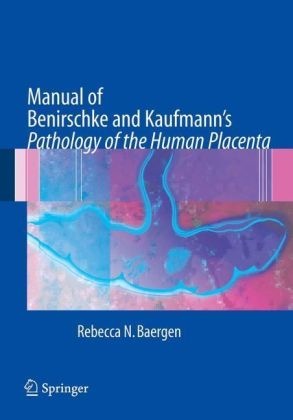Read more
Benirschke and Kaufmann's Pathology of the Human Placenta has long been regarded as the gold standard in the field. It is comprehensive and thorough and contains the detail necessary for those in the subspecialties of placental, perinatal and pediatric pathology. However, placentas are relatively common specimens and are not examined primarily by specialists in the field, but by general pathologists. Thus, there is a need for a more practical and concise manual that can be used by pathology trainees and generalists in their daily work. Manual of Benirschke and Kaufmann's Pathology of the Human Placenta will fill that need. The Manual is a practical, user-friendly guidebook for the general pathologist and pathologist in training for everyday, bench-side use. Organized in 27 chapters, the book will discuss placental development, general features, approach to the specimen by macroscopic and microscopic evaluation, all aspects of placental abnormalities and lesions, disease processes and the placenta, legal aspects of the placental examination, future directions and much more. The sections on macroscopic and microscopic evaluations feature quick-reference tables that allow the reader to identify abnormalities, learn the situations where they occur, and refer back to the text for in-depth discussions. Each chapter will end with selected readings from Pathology of the Human Placenta for more detailed discussions, classic recommended readings, as well as an up-to-date bibliography of current literature. A must-have for every pathologist and pathology resident.
List of contents
From the contents:
Approach to the specimen.- Normal Development and Histology.- Multiple Gestation: Multiple Gestation.- Abnormalities of the Placenta.- Disease Processes and the Placenta.- Neoplasms and Gestational Trophoblastic Disease.- Legal Aspects and Future Directions.- Appendix.
About the author
Rebecca N. Baergen obtained her MD from the University of California, Los Angeles, School of Medicine in 1983 and completed her residency training in pathology at the Los Angeles County Harbor-UCLA Medical Center. Dr. Baergen was a member of the faculty of the University of California at San Diego until transferring to the Weill Medical College of Cornell University in 1997. Dr. Baergen trained with Dr. Kurt Benirschke, one of the pioneers in placental and perinatal pathology and co-author of this book. Dr. Baergen is now Professor of Clinical Pathology and Laboratory Medicine and Chief of Perinatal and Pediatric Pathology at Weill Medical College, as well as Attending Pathologist at NewYork-Presbyterian Hospital. Dr. Baergen has lectured and published extensively in this field and her special interests include the pathogenesis of fetal demise, fetal growth restriction, placental malperfusion, maternal thrombophilias, fetal vascular thrombosis, and abnormalities of the umbilical cord.

